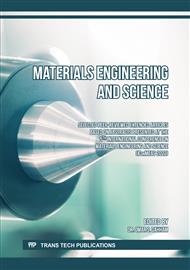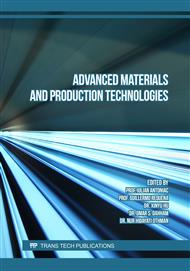[1]
S. F. Miller, A. J. Shih, and J. Qu, Investigation of the spark cycle on material removal rate in wire electrical discharge machining of advanced materials,, Int. J. Mach. Tools Manuf., vol. 44, no. 4, p.391–400, Mar. (2004).
DOI: 10.1016/j.ijmachtools.2003.10.005
Google Scholar
[2]
S. Sarkar, S. Mitra, B. B, Parametric analysis and optimization of wire electrical discharge machining of γ-titanium aluminide alloy,,-J. of materials processing., vol. 159, p.286–294, (2005).
DOI: 10.1016/j.jmatprotec.2004.10.009
Google Scholar
[3]
N. Z. Khan, M. A. Wahid, S. Singh, A. N.Siddiquee, and Z.A. KHAN, Study on micro hardness in wire electrical discharge machining based on taguchi method,, International Journal of Mechanical and Production Engineering., vol-1,Issue-1, (2013).
Google Scholar
[4]
Y. Fan, J. Bai, C. Li, and W. Xu, Research on Precision Pulse Power Technology of WEDM,, Procedia CIRP, vol. 6, p.267–273, Jan. (2013).
DOI: 10.1016/j.procir.2013.03.090
Google Scholar
[5]
Kuriachen Basil, Josephkunju Paul, and Jeoju M.Issac, Spark gap optimization of WEDM process on Ti6Al4V,, International Journal of Engineering Science and Innovative Technology., vol. 2, Issue 1, January (2013).
Google Scholar
[6]
V. N. Najm, Experimental investigation of wire EDM process parameters on heat affected zone,, Eng. Technol. J., vol. 36, no. 1, p.64–70, (2018).
DOI: 10.30684/etj.2018.136755
Google Scholar
[7]
M. Patil, G. Naik, P. N., Analysis of process parameters in wire EDM with stainless steel 410 using topics method,, J. Emerg. Technol. Innov. Res, vol. 5, p.728–735, (2018).
Google Scholar
[8]
Manikandan D., Gokul Raja S., Joel J., Karthick S., and Karthikeyan A. S., Optimisation machining process parameters in wire cut EDM,, International Journal of Innovative Research in Science, Engineering and Technology, vol. 5, special Issue 8, May, (2016).
Google Scholar
[9]
H. Al-Ethari and Z. Fadhil, Investigation of the effect of wire electrical discharge machining on the fracture toughness of aluminum-boron carbide composite,, IOP Publishing, vol. 1094, no. 1. (2021).
DOI: 10.1088/1757-899x/1094/1/012162
Google Scholar
[10]
R. M. Kirwin, J. C. Moller, and M. P. Jahan, Modification and adaptation of wire lag model based on surface feed for improving accuracy in wire EDM of Ti-6Al-4V alloy,, Int. J. Adv. Manuf. Technol., vol. 117, no. 9, p.2909–2920, Aug.(2021).
DOI: 10.1007/s00170-021-07870-1
Google Scholar
[11]
Arshad R., Mehmood S., Shah M., Imran M., Qayyum F., Effect of distilled water and kerosene as dielectrics on machining rate and surface morphology of Al-6061 during electric discharge machining,, Advances in Science and Technology Research Journal, vol. 13(3):162–169, (2019).
DOI: 10.12913/22998624/111846
Google Scholar
[12]
D. Poroś, S. Zaborski, and T. Stechnij, Analysis of WEDM application to cutting tools manufacturing for manual shaping of flat surfaces,, in AIP Conference Proceedings, vol., no. 1, p.20023, (2017).
DOI: 10.1063/1.5056286
Google Scholar
[13]
R. S. Parihar, R. K. Sahu, and G. Srinivasu, Effect of wire electrical discharge machining on the functionally graded cemented tungsten carbide surface integrity,, Mater. Today Proc., vol. 5, no. 14, p.28164–28169, (2018).
DOI: 10.1016/j.matpr.2018.10.059
Google Scholar



